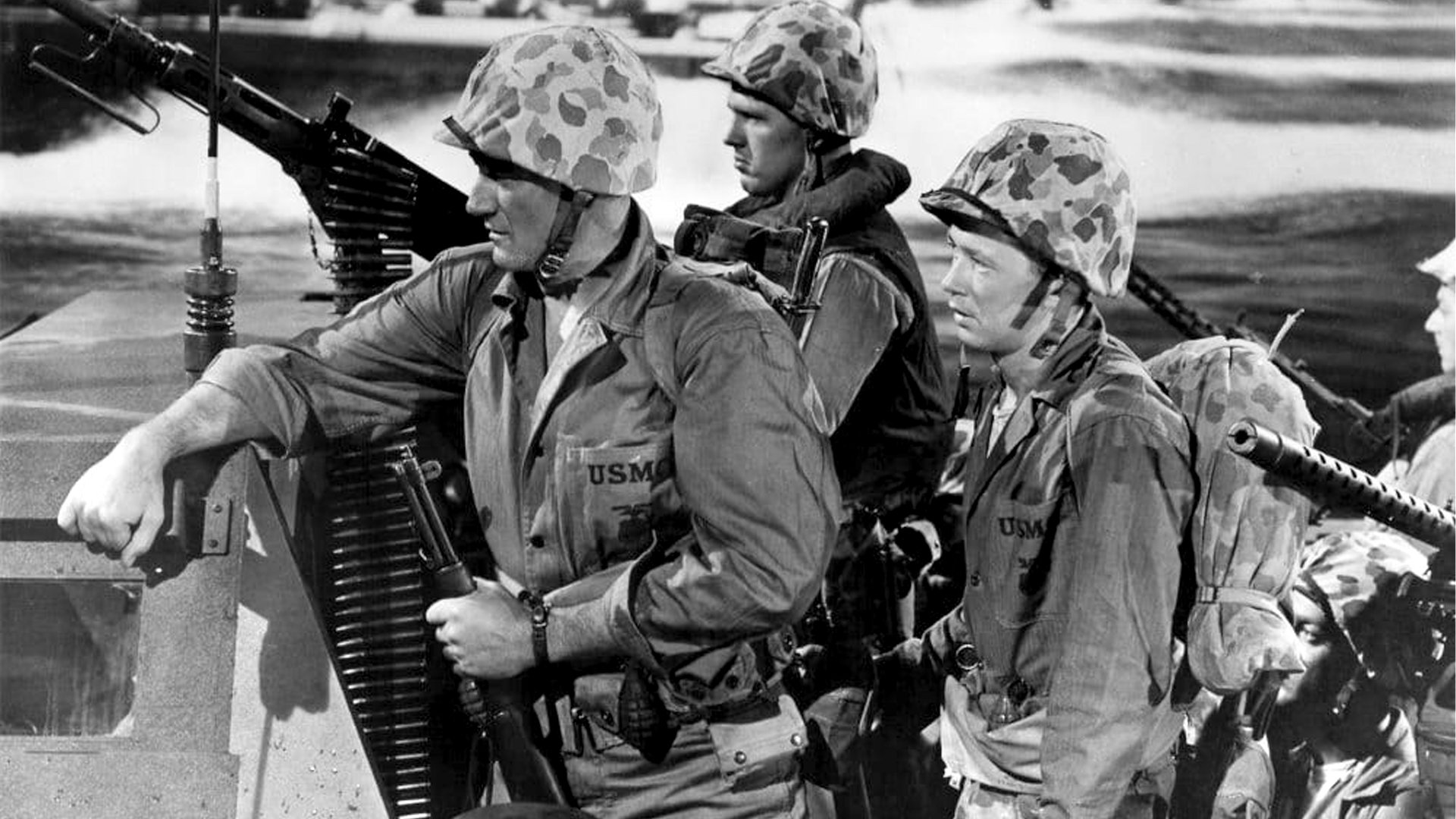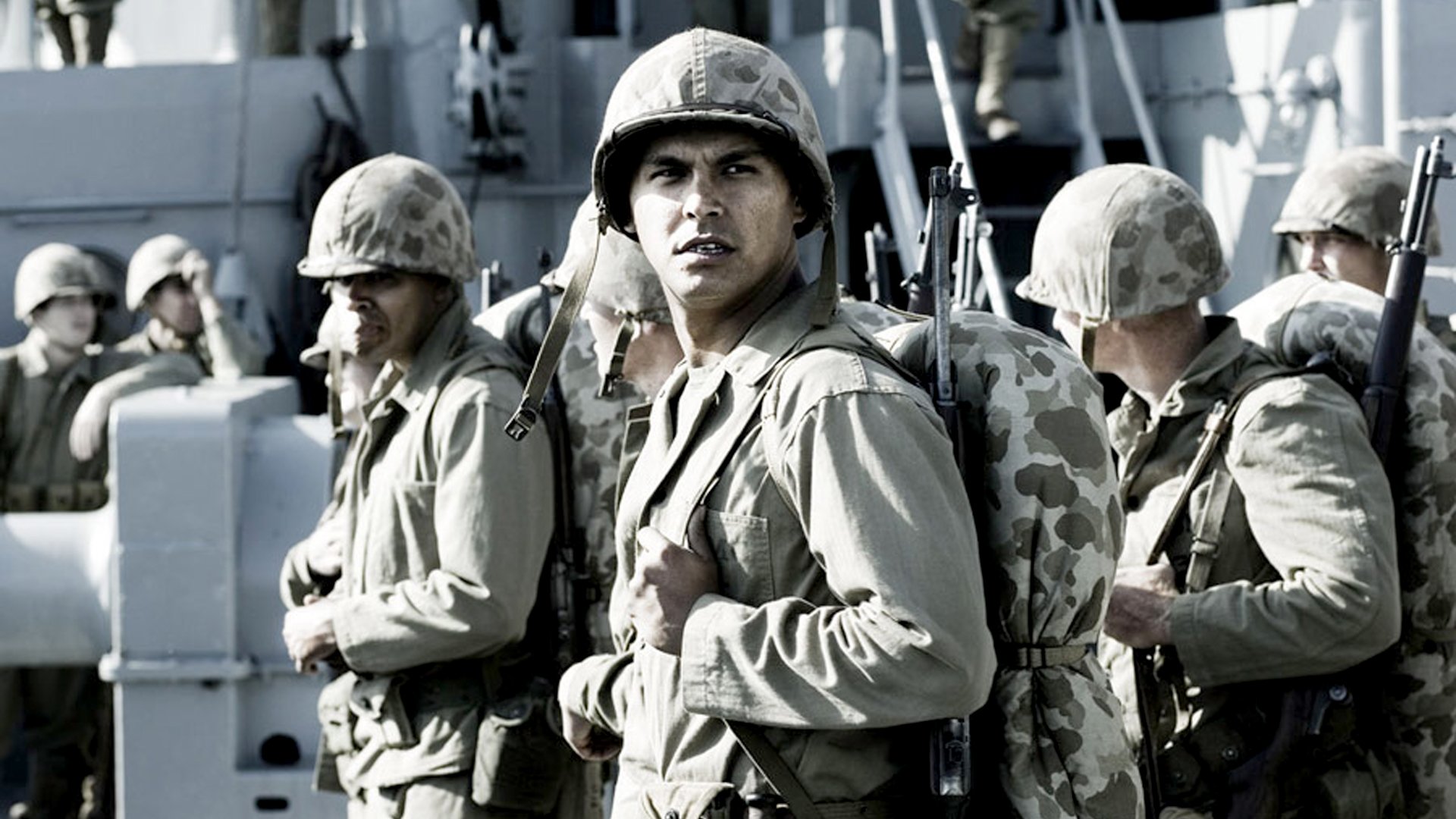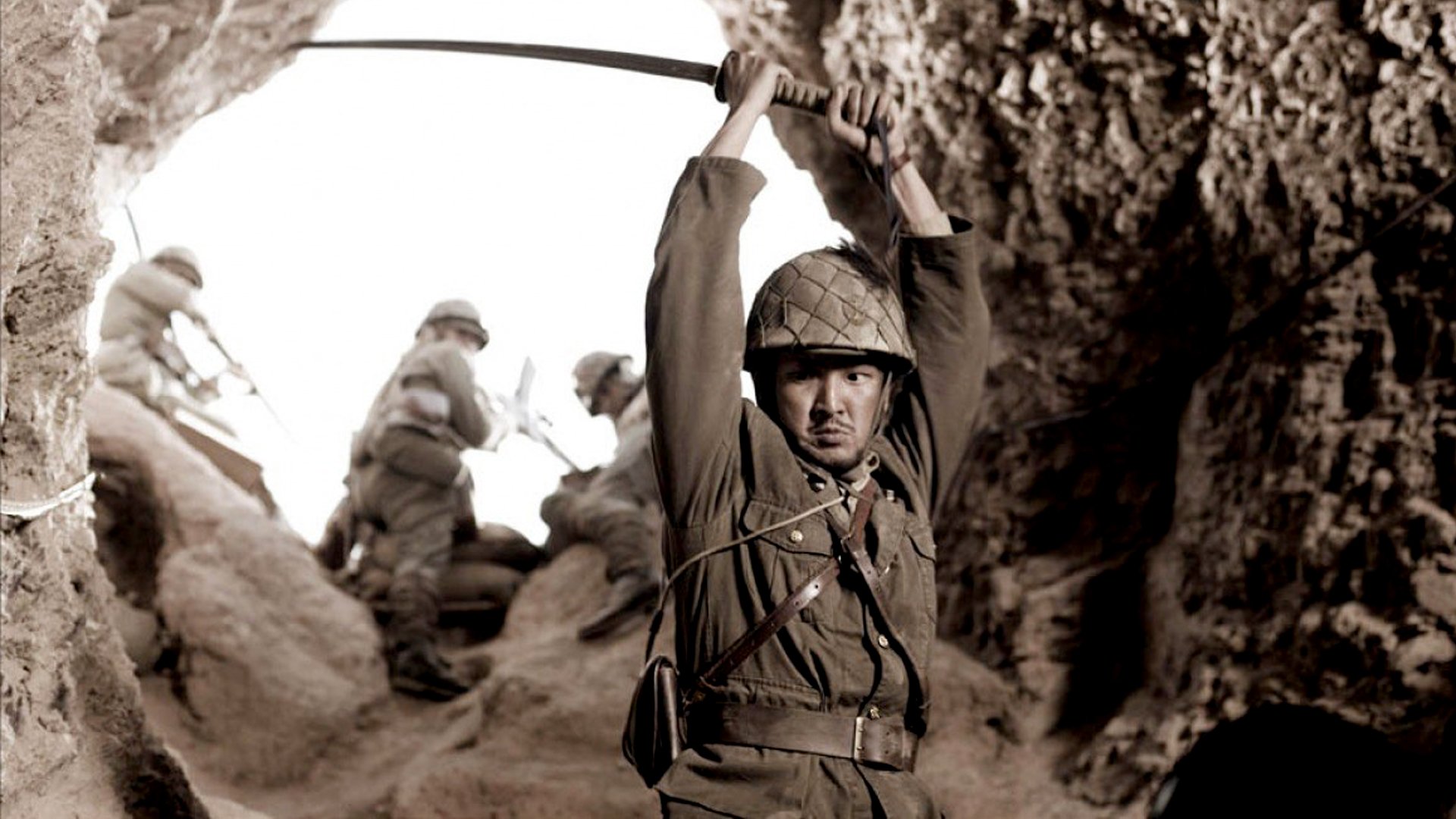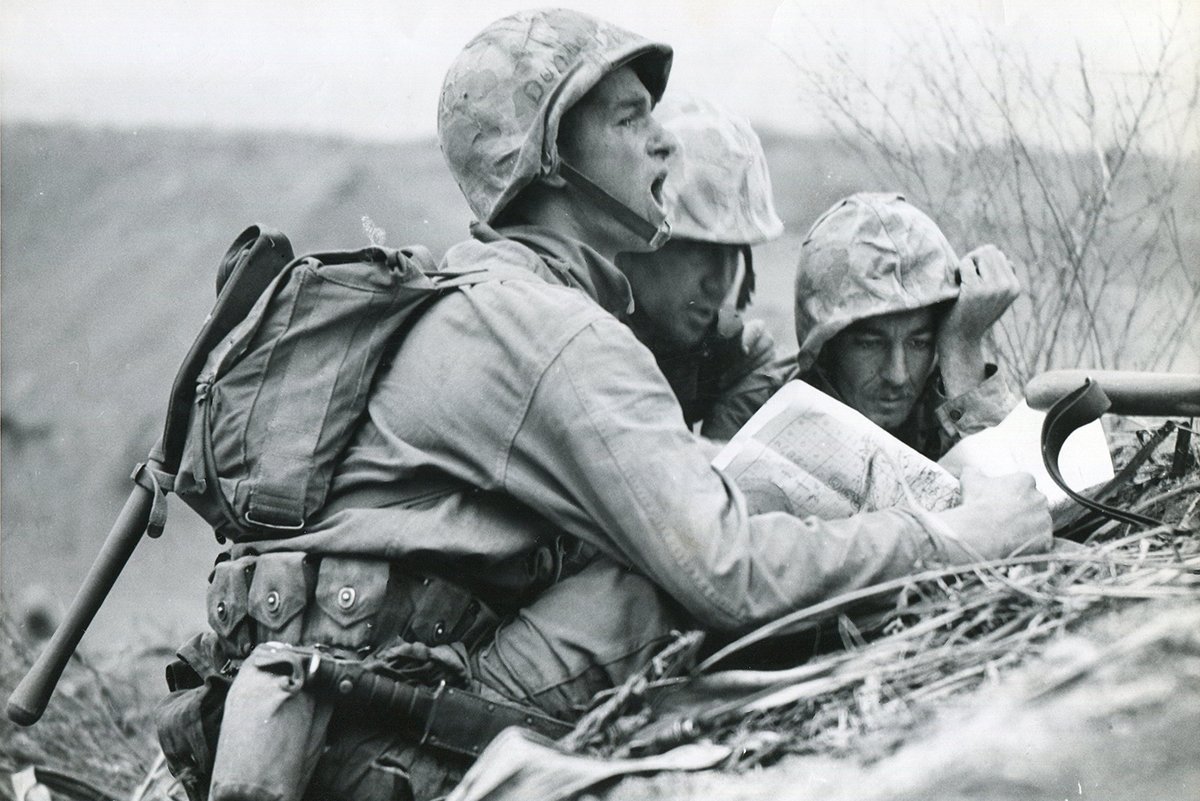
Sculptures of James Bradley, left; Harlan Block, center; and Rene Gagnon, right, are shown hoisting the flag, though neither Bradley nor Gagnon was actually in Rosenthal’s iconic photograph. Photo courtesy of Wikimedia Commons.
On Feb. 19, 1945, three Marine Divisions landed on the black volcanic beaches of Iwo Jima. The island, located in the western Pacific, was a virtual fortress. In the year prior to the Marines’ arrival, the Japanese had constructed a vast network of bunkers and tunnels that allowed them to endure six months of near-daily aerial and naval bombardments.
Now the grunts had come to do what couldn’t be accomplished from afar: eliminate the island’s defenders at bayonet range and seize Iwo Jima’s three airfields. For more than a month, US Marines and sailors fought desperately to take the island, using flamethrowers and explosives to clear the enemy out of their subterranean defenses.
By the time the island was finally secured, American casualties (killed and wounded) outnumbered the Japanese by an estimated 9,000 men. It was the only engagement during World War II in which the United States suffered more casualties than the Japanese. It was also the deadliest battle in Marine Corps history. Nearly 7,000 US Marines, sailors, and soldiers were killed on Iwo Jima.
In the almost eight decades since Iwo Jima, Hollywood has churned out a number of films and television shows depicting the war in the Pacific. Some do a good job of re-creating what actually happened but are cinematically uncompelling. Others are light on facts but still worth watching for sheer entertainment. Yet a select few succeed in merging action and spectacle with historical accuracy.
Related: Col. Dave Severance, Commander of Marines Who Raised Flag on Iwo Jima, Dies at 102
John Wayne and Sands of Iwo Jima
The first major Hollywood production to tackle the infamous battle was Sands of Iwo Jima. The blockbuster film was released just four years after the end of World War II and features John Wayne as the fictional Sgt. John Stryker. It’s filled with the kind of grandiose, macho dialogue moviegoers would expect from a war movie starring the Duke. But for all of its romanticizing and bravado, Sands of Iwo Jima manages to portray the true brutality of the battle.

John Wayne starred alongside several veterans of the battle in Sands of Iwo Jima. Screenshot from Sands of Iwo Jima.
One thing that sets Sands of Iwo Jima apart is that the 100-minute movie is filled with actual war footage. Throughout the film, clips of real Marines fighting on Tarawa and Iwo Jima are seamlessly intermixed with staged reenactments. Much of the combat footage was borrowed from a documentary titled With the Marines at Tarawa, which won the Marine Corps an Oscar in 1944.
The film also highlights America's extensive use of Sherman M4A3 tanks in the battle. Also known as “zippo tanks,” the M4A3s were specially outfitted to spew streams of napalm up to 150 yards. This proved devastatingly effective against the dug-in enemy. On average, the Marines used an estimated 10,000 gallons of napalm per day during the operation.
Also noteworthy: Several of the men originally credited with raising the American flag over Iwo Jima portray themselves in the film. As the final scene begins, Wayne hands a folded flag to the three real-life combat veterans and instructs them to find a way to raise it. The movie then cuts to a re-creation of Sgt. William Genaust’s famous documentary footage of the Marines hoisting the flag on Mount Suribachi.
Related: WATCH: The Bloody Documentary That Won The Marine Corps An Oscar
One Iwo Jima Movie Wasn’t Enough for Director Clint Eastwood
In the mid-2000s, Clint Eastwood decided to try his hand at making a movie about Iwo Jima. He chose to base his film on the best-selling nonfiction book by James Bradley and Ron Powers, Flags of Our Fathers.

Adam Beach stars as Ira Hayes in Flags of Our Fathers. Screenshot from Flags of Our Fathers.
The book tells the story of James Bradley’s father, John Bradley, who participated in the battle as a Navy corpsman. Bradley received the Navy Cross for his actions on Iwo Jima and was also long-believed to be one of six Marines in Joe Rosenthal’s famous photograph of the American flag being raised atop Mount Suribachi.
Eastwood’s screen adaptation cuts back and forth between the battle and the story of what happened afterward to Bradley (played by Ryan Phillippe) and the two other alleged flag-raisers who survived the war. Upon returning home to the United States, the trio was sent on a national publicity tour so they could leverage their newfound fame to raise money for the war effort.
The movie is unique in that it recounts how some of the men in the photograph were misidentified and how the US War Department stifled attempts to correct the record. Of the three survivors originally believed to be in the photograph, only one — Ira Hayes — is still credited with raising the flag over Iwo Jima.
Flags of Our Fathers grossed $33.6 million at the box office when it debuted in 2006. Eastwood then immediately made and released a companion film, Letters From Iwo Jima.
Related: Why the Marine Corps Memorial Features Men Who Weren’t in the Famous Photograph
Letters From Iwo Jima Was a Big Hit in Japan

Letters From Iwo Jima was released the same year as Flags of Our Fathers and depicted the battle from the Japanese perspective. Screenshot from Letters From Iwo Jima.
Letters From Iwo Jima premiered in theaters later the same year as Flags of Our Fathers. Like the first film, the second tells the story of the battle, except from a Japanese, rather than an American, vantage point. The film, which depicts the average Japanese soldier more sympathetically than most American movies about World War II, was positively received in Japan.
Scripted almost entirely in Japanese, Letters From Iwo Jima stars Japanese actors rather than Asian-American actors. In 2007, it became one of only nine foreign language films to ever be nominated for Best Picture at the Academy Awards.
As with Flags of Our Fathers, Eastwood did his research to ensure Letters From Iwo Jima is more truth than fiction. In one of film’s more notable scenes, a Japanese lieutenant is seen strapping anti-tank mines to his body and concealing himself among the bodies of his fallen comrades. This was based on the real story of Satoru Omagari, who was among the few Japanese survivors of the battle. During the battle, Omagari strapped mines to himself with the intention of blowing up an American tank, but he never got close enough to one to carry out his plan.
Related: The Medal of Honor Recipient Who Refused To Die: He Enlisted at 14, Dove on 2 Grenades at 17
What the Movies Missed
Like most cinematic depictions of Iwo Jima, Eastwood’s two films both offer panoramic views of the battle aimed at capturing its significance within the larger context of the war. In contrast, Sands of Iwo Jima is more character-driven, but its characters are not based on real people. Few movies have highlighted the incredible stories of individuals who were actually there.

Marines call for fire on a Japanese position during the battle. Photo by Thayer Soule, courtesy of Wikimedia Commons.
Twenty-seven Medals of Honor were awarded to Marines and sailors for their actions on Iwo Jima — more than for any other engagement in American history. More than 200 Navy Crosses were also earned in the battle. Behind each of those awards is an incredible story, and very few of them have ever been told in films or on television shows.
Another important detail that Hollywood tends to overlook is the fact that the US Army also participated in the battle. Almost 3,000 soldiers from the Ohio National Guard fought on Iwo Jima, and 15 of them were killed in action. The relatively small detachment was credited with killing 1,602 Japanese soldiers and capturing 867 more — approximately 10% of the entire Japanese force.
By the time the smoke cleared over Iwo Jima, nearly 7,000 Americans and nearly 18,000 Japanese lay buried in temporary graves across the island. Today, the remains of more than 10,000 Japanese soldiers remain missing somewhere on Iwo Jima’s eight square miles of volcanic sand and rock.
Read Next: ‘The Purest Democracy’ Is an Awe-Inspiring Eulogy for the Fallen on Iwo Jima

Mac Caltrider is a senior staff writer for Coffee or Die Magazine. He served in the US Marine Corps and is a former police officer. Caltrider earned his bachelor’s degree in history and now reads anything he can get his hands on. He is also the creator of Pipes & Pages, a site intended to increase readership among enlisted troops. Caltrider spends most of his time reading, writing, and waging a one-man war against premature hair loss.
BRCC and Bad Moon Print Press team up for an exclusive, limited-edition T-shirt design!
BRCC partners with Team Room Design for an exclusive T-shirt release!
Thirty Seconds Out has partnered with BRCC for an exclusive shirt design invoking the God of Winter.
Lucas O'Hara of Grizzly Forge has teamed up with BRCC for a badass, exclusive Shirt Club T-shirt design featuring his most popular knife and tiomahawk.
Coffee or Die sits down with one of the graphic designers behind Black Rifle Coffee's signature look and vibe.
Biden will award the Medal of Honor to a Vietnam War Army helicopter pilot who risked his life to save a reconnaissance team from almost certain death.
Ever wonder how much Jack Mandaville would f*ck sh*t up if he went back in time? The American Revolution didn't even see him coming.
A nearly 200-year-old West Point time capsule that at first appeared to yield little more than dust contains hidden treasure, the US Military Academy said.












